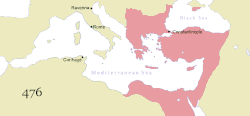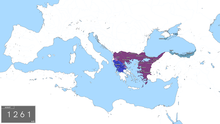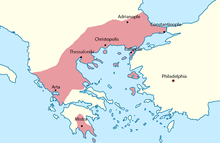Byzantine Empire
| |||||||||
|---|---|---|---|---|---|---|---|---|---|
| 1261–1453 | |||||||||
| Motto: Βασιλεὺς Βασιλέων, Βασιλεύων Βασιλευόντων Basileus Basileōn, Basileuōn Basileuontōn (English: "King of Kings, Ruling Over Kings") | |||||||||
The Despotate of Epirus in dark blue, the Empire of Trebizond in light blue and the Principality of Theodoro in violet. | |||||||||
| Capital | Constantinople | ||||||||
| Common languages | |||||||||
| Religion | Greek Orthodoxy (Predominantly), Roman Catholicism and Sunni Islam (Minority) | ||||||||
| Demonym(s) | Byzantine Greek | ||||||||
| Government | Absolute monarchy | ||||||||
| Emperor | |||||||||
• 1261–1282 | Michael VIII | ||||||||
• 1282–1328 | Andronikos II | ||||||||
• 1295–1320 | Michael IX | ||||||||
• 1328–1341 | Andronikos III | ||||||||
• 1341–1376 | John V | ||||||||
• 1347–1354 | John VI | ||||||||
• 1376–1379 | Andronikos IV | ||||||||
• 1379–1390 | John V | ||||||||
• 1390 | John VII | ||||||||
• 1390–1391 | John V | ||||||||
• 1391–1425 | Manuel II | ||||||||
• 1425–1448 | John VIII | ||||||||
• 1448–1453 | Constantine XI | ||||||||
| History | |||||||||
• Reconquest of Constantinople from the Latins | 1261 | ||||||||
• Fall of Constantinople to the Ottomans | 1453 | ||||||||
| |||||||||
| History of the Byzantine Empire |
|---|
 |
| Preceding |
| Early period (330–717) |
| Middle period (717–1204) |
| Late period (1204–1453) |
| Timeline |
| By topic |
|
|
The Byzantine Empire was ruled by the Palaiologos dynasty in the period between 1261 and 1453, from the restoration of Byzantine rule to Constantinople by the usurper Michael VIII Palaiologos following its recapture from the Latin Empire, founded after the Fourth Crusade (1204), up to the Fall of Constantinople to the Ottoman Empire. Together with the preceding Nicaean Empire and the contemporary Frankokratia, this period is known as the late Byzantine Empire.
From the start, the regime faced numerous problems.[1] The Turks of Asia Minor had begun conducting raids and expanding into Byzantine territory in Asia Minor by 1263, just two years after the enthronement of the first Palaiologos emperor Michael VIII. Anatolia, which had formed the very heart of the shrinking empire, was systematically lost to numerous Turkic ghazis, whose raids evolved into conquering expeditions inspired by Islamic zeal, the prospect of economic gain, and the desire to seek refuge from the Mongols[2] after the disastrous Battle of Köse Dağ in 1243. The Palaiologoi were engaged on several fronts, often continually, while the empire's supply of food and manpower dwindled. In this period, the Byzantine Empire found itself continually at war, both civil and interstate, with most interstate conflicts being with other Christian empires. Most commonly, these comprised the Second Bulgarian Empire, the Serbian Empire, the remnants of the Latin Empire and even the Knights Hospitaller.
The loss of land in the East to the Turks and in the West to the Bulgarians coincided with two disastrous civil wars, the Black Death, and the 1354 earthquake at Gallipoli which allowed the Turks to occupy the peninsula. By 1380, the Byzantine Empire consisted of the capital Constantinople and a few other isolated exclaves, which only nominally recognized the Emperor as their lord. Nonetheless, Byzantine diplomacy, political intrigue and the invasion of Anatolia by Timur allowed Byzantium to survive until 1453. The last remnants of the Byzantine Empire, the Despotate of the Morea and the Empire of Trebizond, fell shortly afterwards.
However, the Palaiologan period witnessed a renewed flourishing in art and the letters, in what has been called the Palaiologian Renaissance. The migration of Byzantine scholars to the West also helped to spark the Italian Renaissance.




